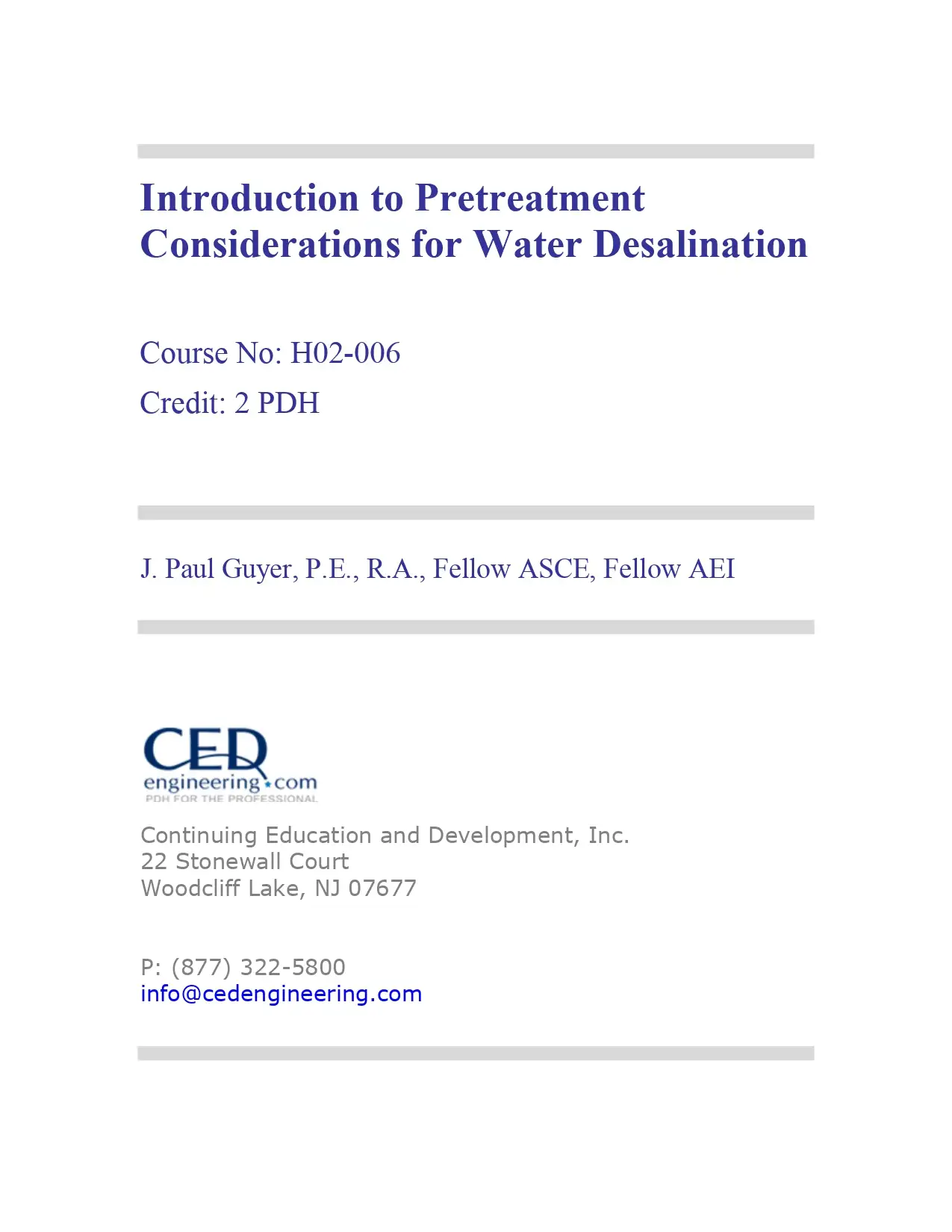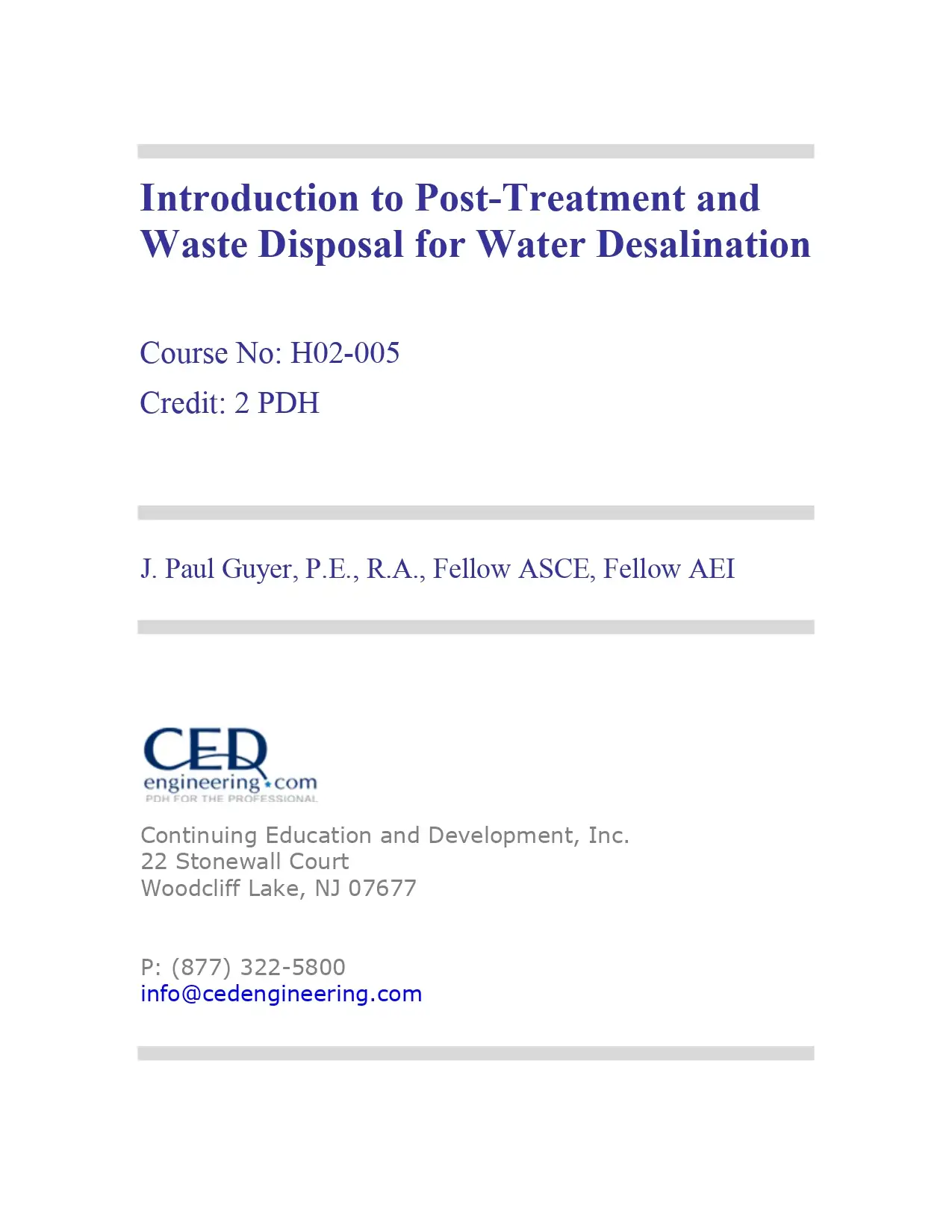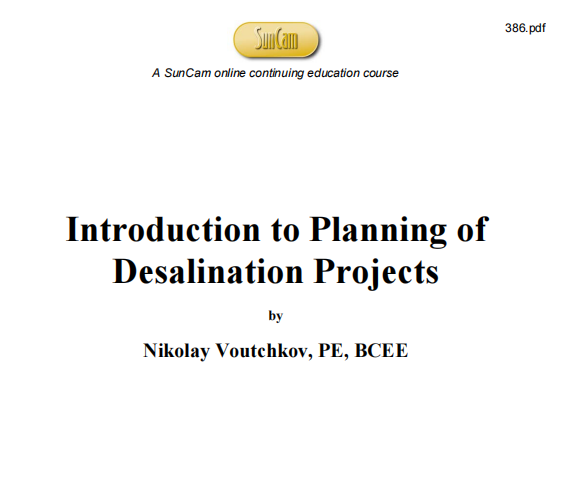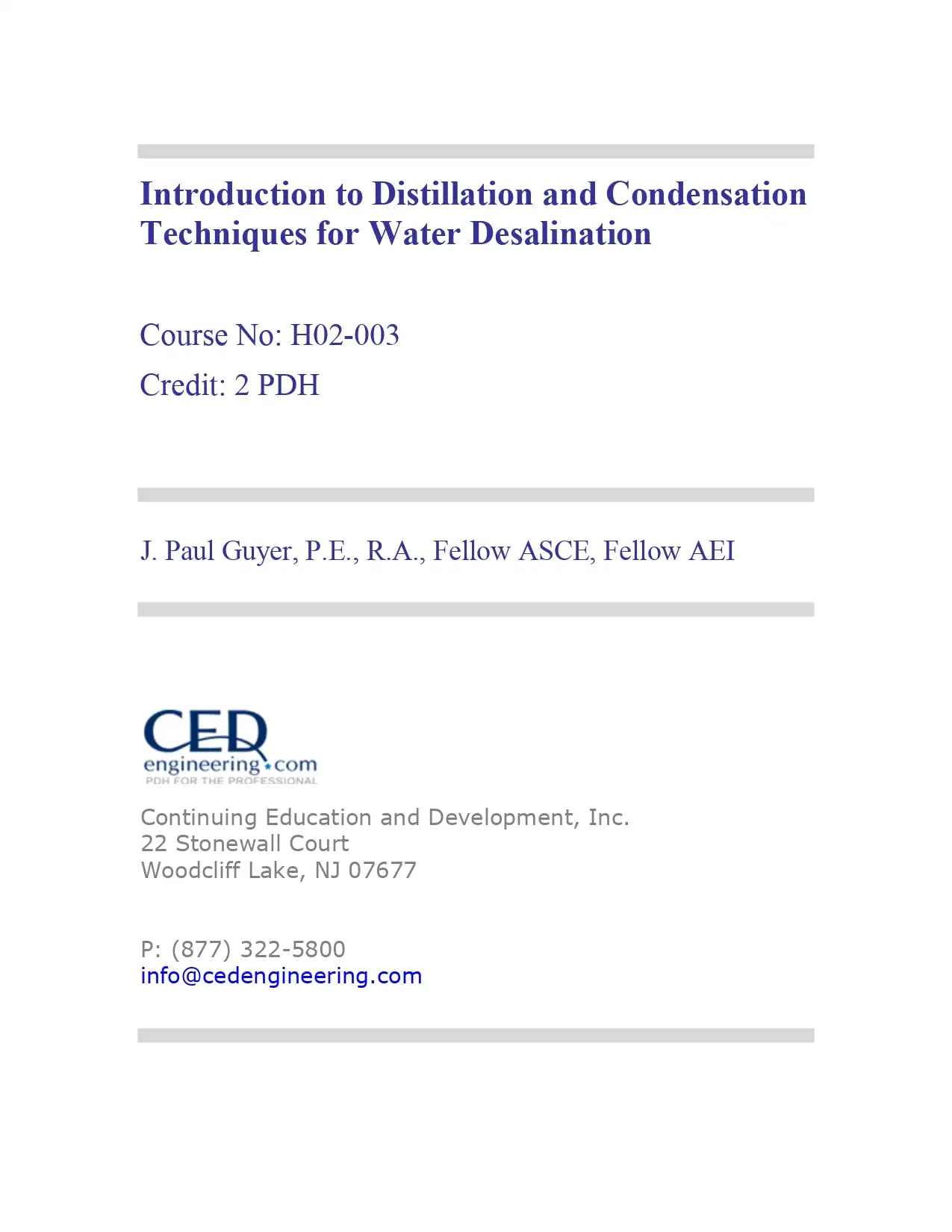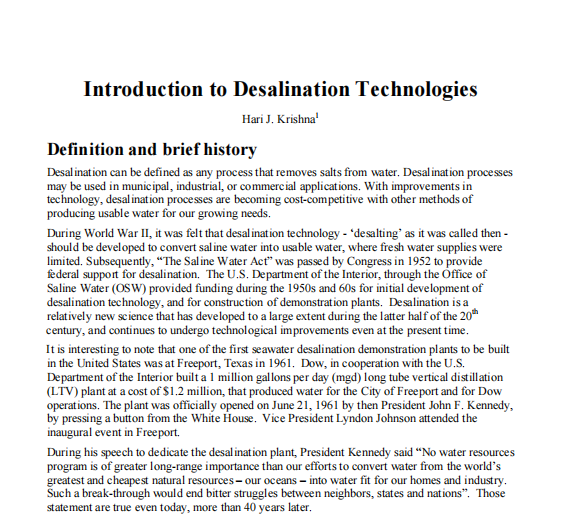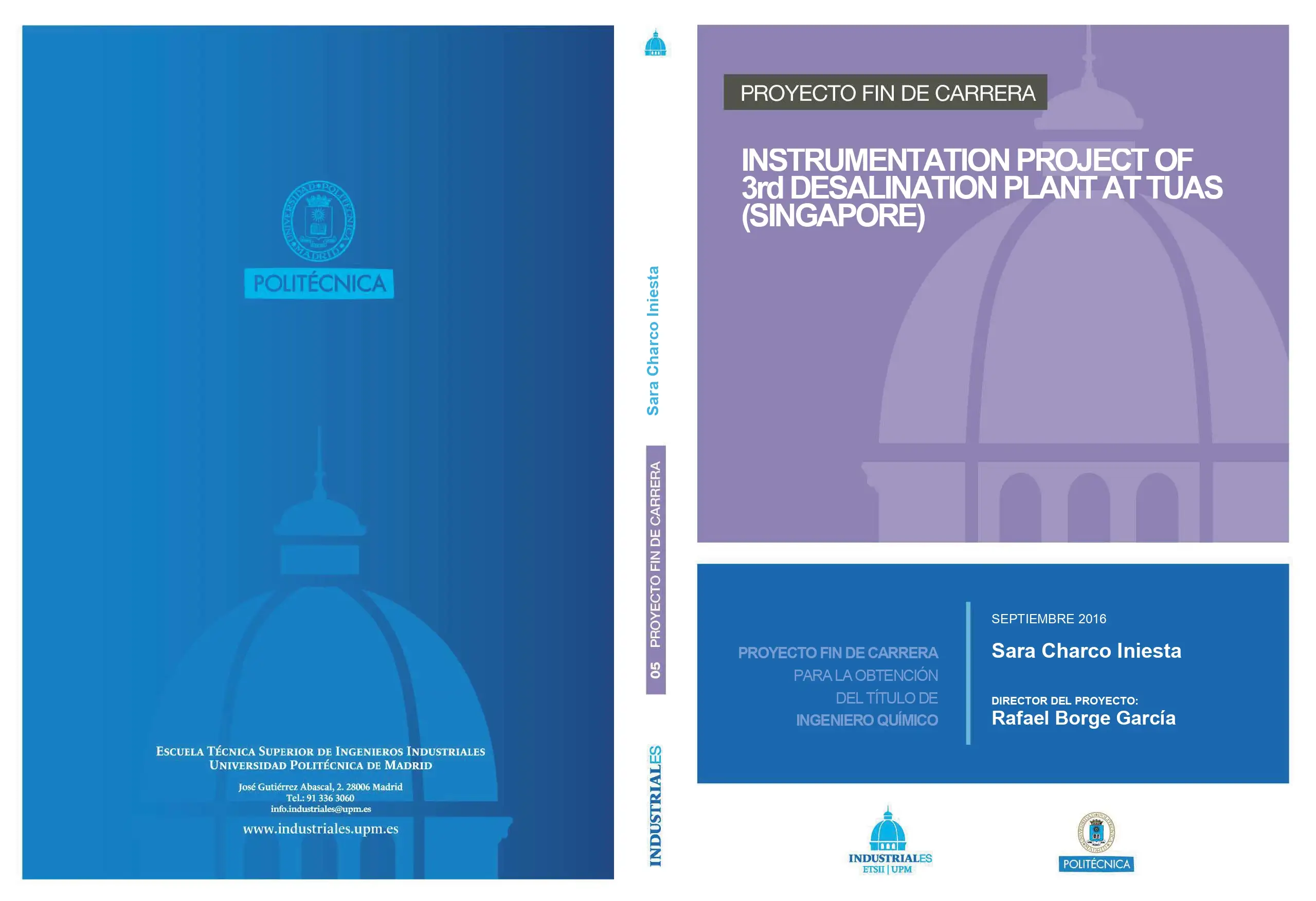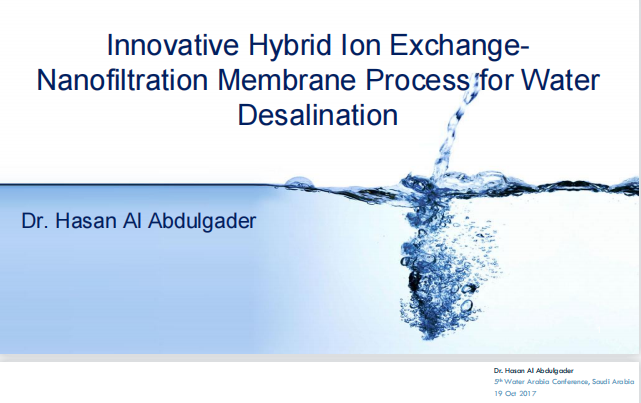Introduction to Planning of Desalination Projects
INTRODUCTION:
The purpose of project planning is to define the size, location and scope of the desalination project and chart a roadmap for project implementation. The first step of project planning is to determine the area that the desalination plant must serve, identify the type of water use and assess the water demand and quality requirements of each water customer over the useful life of the desalination project, typically 25 to 30 years. Once the project size and service area are determined, the next step of the planning process is to define the project. This requires identifying the most viable plant site location, intake and discharge type and configurations, characterization of source water quality and selection of the treatment process. The selection of the most cost-effective and environmentally sound desalination project location and configuration is based on a thorough evaluation of a number of alternatives for key desalination project components such as saline source water intake, concentrate discharge, pretreatment, RO system, post-treatment and product water delivery system. Once the project scope and schedule are defined, the project environmental impact assessment must be prepared. Project entitlements such as legal rights to land use, water rights for source water collection; easements for project-related infrastructure; rights-of-way; electric power supply agreement; and environmental permits, licenses and other regulatory, legal and contractual documentation, need to be obtained. This process can take several months to one of more years, depending on the governance environment and project size and complexity.
Introduction to Planning of Desalination Projects
INTRODUCTION:
The purpose of project planning is to define the size, location and scope of the desalination project and chart a roadmap for project implementation. The first step of project planning is to determine the area that the desalination plant must serve, identify the type of water use and assess the water demand and quality requirements of each water customer over the useful life of the desalination project, typically 25 to 30 years. Once the project size and service area are determined, the next step of the planning process is to define the project. This requires identifying the most viable plant site location, intake and discharge type and configurations, characterization of source water quality and selection of the treatment process. The selection of the most cost-effective and environmentally sound desalination project location and configuration is based on a thorough evaluation of a number of alternatives for key desalination project components such as saline source water intake, concentrate discharge, pretreatment, RO system, post-treatment and product water delivery system. Once the project scope and schedule are defined, the project environmental impact assessment must be prepared. Project entitlements such as legal rights to land use, water rights for source water collection; easements for project-related infrastructure; rights-of-way; electric power supply agreement; and environmental permits, licenses and other regulatory, legal and contractual documentation, need to be obtained. This process can take several months to one of more years, depending on the governance environment and project size and complexity.
Introduction to Desalination Project Design and Delivery
Introduction:
Once the desalination plant service area, location, site, source water quality, product water quality and concentrate water quality are determined, and the intake and discharge type and configuration are selected, the next step of the desalination project planning process is to complete conceptual plant design. The conceptual design includes the type and sequence of the treatment processes and equipment, facility and equipment design criteria and incorporates preliminary plant site layout and hydraulic profile. It also includes project capital and O&M cost estimates and the project implementation schedule. Furthermore, the conceptual design addresses the type of technology and equipment for energy recovery from the plant concentrate, post-treatment of the plant RO permeate, handling and disposal of the solid and liquid waste streams generated during source water pretreatment and membrane cleaning and finally, plant product water storage and delivery systems. The conceptual plant design process takes under consideration the physical, operational and environmental constraints imposed on the project, and usually involves initial development of several project alternatives, followed by selection of the most viable alternative based on a set of criteria. This includes capital and O&M costs, size of the overall plant site footprint, environmental impacts, carbon footprint of plant, ease of plant operation and maintenance, overall plant performance in terms of energy and chemical use, plant fresh water production reliability, redundancy and spare capacity, plant expansion and phasing flexibility and ability of the proposed plant design and facility configuration to accommodate future technologies and equipment.
Introduction to Desalination Project Design and Delivery
Introduction:
Once the desalination plant service area, location, site, source water quality, product water quality and concentrate water quality are determined, and the intake and discharge type and configuration are selected, the next step of the desalination project planning process is to complete conceptual plant design. The conceptual design includes the type and sequence of the treatment processes and equipment, facility and equipment design criteria and incorporates preliminary plant site layout and hydraulic profile. It also includes project capital and O&M cost estimates and the project implementation schedule. Furthermore, the conceptual design addresses the type of technology and equipment for energy recovery from the plant concentrate, post-treatment of the plant RO permeate, handling and disposal of the solid and liquid waste streams generated during source water pretreatment and membrane cleaning and finally, plant product water storage and delivery systems. The conceptual plant design process takes under consideration the physical, operational and environmental constraints imposed on the project, and usually involves initial development of several project alternatives, followed by selection of the most viable alternative based on a set of criteria. This includes capital and O&M costs, size of the overall plant site footprint, environmental impacts, carbon footprint of plant, ease of plant operation and maintenance, overall plant performance in terms of energy and chemical use, plant fresh water production reliability, redundancy and spare capacity, plant expansion and phasing flexibility and ability of the proposed plant design and facility configuration to accommodate future technologies and equipment.
Innovative Hybrid Ion Exchange Nanofiltration Membrane Process for Water Desalination
INTRODUCTION:
- Word population > 7,000,000,000 and increasing.
- Rapidly diminishing recourses of clean and potable water.
- Higher rate of water consumption in developing countries.
- Desalination is the one of the most important solutions for the water crises.
- Desalination accounts for >55% of potable water consumption in the country.
- Current desalination technologies is hampered by high energy consumption.
Innovative Hybrid Ion Exchange Nanofiltration Membrane Process for Water Desalination
INTRODUCTION:
- Word population > 7,000,000,000 and increasing.
- Rapidly diminishing recourses of clean and potable water.
- Higher rate of water consumption in developing countries.
- Desalination is the one of the most important solutions for the water crises.
- Desalination accounts for >55% of potable water consumption in the country.
- Current desalination technologies is hampered by high energy consumption.


